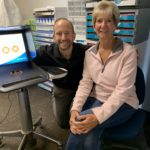
Dr. Gould with a patient, who, like many of Dr. Gould’s patients, opted for a more in-depth comprehensive examination that includes a screening via Cognivue® Thrive.
Sponsored Content
By Solomon Gould, OD, MBA
Dec. 8, 2021
Optometry is progressing at lighting speed. Scope of practice continues to expand state by state, year by year. The OD’s role as a front-line screener for systemic health and vitality is now well established and widely known.
As doctors, we are inundated with new technologies and practice offerings promising to drive up revenue and referrals and offering us a competitive edge. Unfortunately, however, the results of many of these novelties fall short of expectations. Consequently, many ODs become hesitant to invest in new technology.
I knew that I wanted to incorporate something that optimized the core competencies of comprehensive eyecare. That was what led me to Cognivue® Thrive technology, which was recommended to me by a good friend and fellow optometrist. Upon learning the scientific validation and the technology behind Cognivue Thrive, I immediately knew I had discovered exactly what I was looking for. I have since seen the impressive results from use of this technology at both of my practice locations.
The Technology of Adaptive Psychophysics
Cognivue Thrive utilizes a patented technology, Adaptive Psychophysics, to accurately measure people’s ability to receive, process and respond to their visual world. Cognivue Thrive is based on FDA-cleared technology, and has been shown to yield superior test and retest reliability compared to other modalities of assessing cognition such as the Montreal Cognitive Assessment (MoCA) screening 1 and SLUMS.
The Adaptive Psychophysics technology permits anyone to experience the technology regardless of their vision and/or motor skills. Cognivue uses the patient responses during this specific, five-minute, self-administered test to dynamically change and adapt the test to determine their thresholds (best achievable scores) or failure points. The technology objectively detects the stimulus that was captured and identified by the brain, and in so doing, is able to differentiate between stimuli and describe the magnitude or nature of the difference. To highlight the significance of its accuracy, the Cognivue Thrive captures over 32,500 data points in a single test. The Cognivue Thrive is the size of a laptop computer and is portable, permitting flexibility of use and a small office footprint.
Elevating the Standard of Care: Going Beyond Just Helping People See
For decades, basic refraction was the “bread and butter” of an OD’s work. Today, for many ODs, this component has become the responsibility of the technician.
Whether it is the OD or their technician that does this portion of the exam, the OD must analyze this data and ascertain both its validity and the contributing factors that may be at play behind the results. For example, if a patient is diabetic and their refraction yields an appreciably higher myopic shift than would be considered normal, the OD must include this awareness in the care they render for that patient.
The concept of ODs measuring not just visual acuity, but the brain processing of behind vision, is a novelty. I recall vividly the moment that this concept clicked with me. It was on a Sunday evening when I was anxiously dreading leaving the comfort of family time and freedom and going back to work on Monday. I was seeking a higher-level purpose to expand upon the profession of optometry. Oddly enough, I must give all due credit for the ‘aha moment’ to my 10-month-old golden doodle, Maddie. As she always so charmingly does, Maddie was tilting her head side-to-side with an expression of inquisition and curiosity. I must have looked like a mad man in my home office drawing on my marker board and both talking to and answering myself (a tendency that they say is not exactly normal).
I realized at that moment that we can now not only help patients see, but we can also measure how well they process what they are seeing. Additionally, as I will share with you in this article, we can use this information to help our patients preserve their cognitive vitality and their ability to process what they are seeing. The reality is that we look with our eyes, but we see with our brain. I foresee this soon becoming the standard of care. The eyes and the brain are interconnected in so many ways, and they rely on one another for longevity and vitality, as I will also share with you shortly.
A Technology that Increases Practice Profitability
The impact of a new technology on a practice’s performance is an important consideration for most ODs. Though many of us have humanitarian hearts, we must also run a business, and we must do so without the forfeiture of efficacy, ethics and standard of care. The importance of maximizing profitability has increased as a result of optical industry and market changes.
In the past year, I have used the Cognivue Thrive with over 700 patients, a number that is growing by the day. As with any new practice technology, I have tracked its performance along the way using various key performance indicators (KPIs). My new patient ratio, an indication of growth and referrals, has increased 5 percent on average each month. From when we first implemented the technology, my collections per full-time equivalent (FTE), an indication of staff productivity, has increased by $4,000. My revenue per patient, an indication of operational efficiency, has increased by $120. Lastly, this technology has yielded a generous 10.5 percent return on investment (ROI). It has also helped increase our patient retention and compliance with consistent, annual visits.
In addition, I have received countless compliments from patients on the quality of care we now provide at my practices. We have received more goodies from patients than we have the desire or insulin levels to consume. I have several testimonials from patients whose cognitive processing measurements led to referrals and are now stabilized with intervention – all of which would have otherwise gone undiscovered until it was too late for intervention.
My staff and I feel a revitalized, higher-level purpose and sense of pride in our work. We realize that we are helping not only to better our patients’ lives, but we are helping to advance the great profession of optometry.
Supporting Data
The Bidirectionality of Vision and Cognition
The relationship between vision and cognition has been extensively published in several scholarly articles such as JAMA, Internal Medicine, Neurology and many others. Not only has it been validated that preserving and improving vision helps preserve cognitive function, but it has also been validated that the relationship between vision and cognition is bidirectional.
The Cognivue Thrive measures three key cognitive domains: visuospatial, memory and executive function. It also measures both reaction time and processing speed. The visuospatial cognitive domain is the responsibility of the parietal lobes. The parietal lobes allow us to assess our visual scenes and to determine the precise coordinates of those images within our visual scenes. The memory cognitive domain is the responsibility of the temporal lobes. The temporal lobes, using short-term memory, allow us to recognize objects within our visual scenes. The executive function cognitive domain is the responsibility of the frontal lobes. The frontal lobes allow us to focus on and make decisions based on our visual scenes.
How I Implemented Cognivue Thrive in My Practice
The clinical application of Cognivue Thrive will likely vary by doctor. At my practices, I utilize Cognivue Thrive as part of the comprehensive eye examination workup. My teams and I tee up the offering as an upgrade to the standard comprehensive eye exam. We describe it as a more thorough version of the comprehensive eye exam. My patients have been intrigued by the value of also measuring the processing of their vision. Many of my patients now specifically request this more comprehensive version of an annual exam when they book their appointment.
The upgrade fee we utilize for an exam that includes screening using Cognivue Thrive is $40. I also offer it as a standalone appointment or bundled with other holistic diagnostic technologies that I have incorporated into my practices as a package offering. This flexibility of choice has been the reason I have been able to scan 724+ patients so far.
The process itself is efficient and streamlined. My technician conducts the screening in the pretesting room. The patient’s results are placed into their record, which I review prior to seeing them. I then address their results along with their vision, ocular findings and any potential systemic contributions, such as diabetes.
Regardless of the patient’s results, I always introduce them to the CogniWell Program, which provides patients with a complete list of modifiable risk factors that can be addressed to minimize the chances of development and progression of cognitive decline. Concomitantly, it helps patients preserve the processing of their vision, which I have coined as “Cognitive Vision.”
If the patient’s results are borderline or categorized as sub-healthy, I utilize the Cognivue best practices referral guide algorithm. In some cases, this may involve a referral to a primary care physician (PCP) or neurologist for further evaluation. Patients who wish to speak with an expert prior to seeing the doctor I have referred them to, and those who want to discuss the CogniWell Program further, are put in contact with Cognivue Wellness Experts.
Closing Thoughts: Acknowledging the Bidirectionality of Vision & Cognition
The bidirectionality of vision and cognition lends credence to the importance of both the early detection and the risk reduction of cognitive decline. Of the many modifiable risk factors for preserving cognition, vision is not only an important one; it is also easily modifiable. There is so much more to our world than static objects in space. The reality is that cognitive vision has always been there. We just did not see it or have a way to measure it, until now.
The Cognivue Thrive, with its FDA-cleared Adaptive Psychophysics technology, offers superior test and retest reliability compared to other methods and, thus, serves as the best technology to take our standard of care to the next level.
 Solomon Gould, OD, MBA, is the owner of two private practices in the Minneapolis/St. Paul area of Minnesota, as well as a practice management consultant. To contact him: drgould2020@gmail.com
Solomon Gould, OD, MBA, is the owner of two private practices in the Minneapolis/St. Paul area of Minnesota, as well as a practice management consultant. To contact him: drgould2020@gmail.com





















